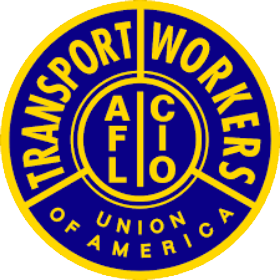TO: Interested Parties
FR: Transport Workers Union of America; Transportation Trades Department, AFL-CIO
DT: 3/8/2024
RE: Public transportation labor considerations in potential DOT/NHTSA AV pilot program
As NHTSA and the larger DOT consider immediate actions to reassert federal leadership on autonomous vehicle regulation, we believe that the DOT’s Innovation Principles should govern the development of federal policy. We offer the following considerations on applying these principles to a potential pilot program that would allow for broad waivers of federal regulations or otherwise incentivize AV deployment. Our unions will use these criteria to assess support/opposition for such a program.
As a threshold matter, we believe that any serious AV pilot program will recognize the unique operating environment that public transportation vehicles move in. Any AV pilot program that includes public transportation must have a separate, transit-specific set of criteria for participants.1 Our unions would strongly and publicly oppose any plan that fails this basic test.
Applicants for a public transportation AV pilot program should be public transportation agencies
Transit agencies are the entities ultimately responsible for the safety of public transportation. They are also the group most connected to the local communities where a pilot project would be run. For workers, transit agencies are also, generally, their employer and bound by collective bargaining agreements to maintain safety and economic conditions. All of these factors combine to make a transit agency the most reasonable applicant for any potential AV pilot program. While we do not oppose allowing manufacturers or others to join together with these agencies for this purpose, we do not believe that the public interest can be served without the agency being a lead party to a potential pilot program.
Pro-worker, pro-safety conditions must be placed on participants in any pilot program
We believe the following requirements would need to be placed on any pilot program that allows AVs to provide public transportation (as defined by 49 USC 5302).
• Presence of a qualified operator on board at all times a vehicle is in operation. The qualified operator must be capable of controlling the vehicle during automation failures and emergencies
• Endorsements for the application from: o the union serving on the Safety Committee established under 49 USC 5329 (hereafter “Safety Committee”) o municipal governing body overseeing the streets the pilot will operate on (this may be the transit agency in same cases)
• Commitment to conduct a safety assessment of the program through the applicant’s Safety Committee. This assessment should be ongoing throughout the life of the program and the results of it should be shared with the DOT and its modal agencies
• Real time incident and accident reporting with data accessible to the public and simultaneously shared with the applicant’s Safety Committee. This data should include, at a minimum, incidents reported through the Standing General Order3 and incidents normally reported to the National Transit Database which occurred on a vehicle included in the program
• Workforce impact analysis associated with the variety of services the pilot intends to perform. This analysis should be similar to the analysis required by the SMART Grant program, but should include job impacts, skills impacts, new jobs or job tasks created, training needs, and other economic data for both the intended deployment and for potential effects if the project were to be extended or expanded
• Commitment to developing an internal workforce directly employed by the applicant that is capable of operating, servicing, and maintaining vehicles covered by the pilot – including potential vehicles that would operate after the pilot ends
